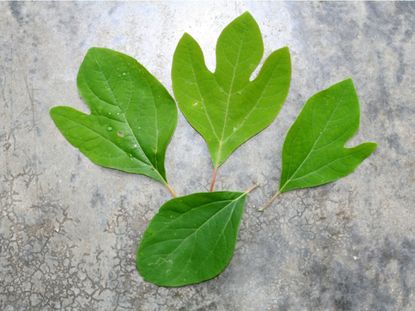What Is A Sassafras Tree: Where Do Sassafras Trees Grow?


A southern Louisiana specialty, gumbo is a delicious stew with a number of variations but is usually seasoned with fine, ground sassafras leaves at the end of the cooking process. What is a sassafras tree and where do sassafras trees grow? Keep reading to learn more.
What is a Sassafras Tree and Where Do Sassafras Trees Grow?
A deciduous tree (or shrub) native to North America, growing sassafras trees can grow to 30 to 60 feet (9 to 18.5 m.) tall by 25 to 40 feet (7.5 to 12 m.) wide with a rounded canopy made up of short layered branches. Long grown for its medicinal properties as well as its fine powder (powdered leaves), the leaves of growing sassafras trees are initially a vibrant green but come autumn they turn glorious colors of orange-pink, yellow-red, and scarlet-purple. These eye-popping colors make it a lovely tree specimen for the landscape, while its canopy habit creates a cool shaded oasis during the hot summer months. The sassafras tree's scientific name is Sassafras albidum and hails from the family Lauraceae. Its 4- to 8-inch (10 to 20.5 cm.) leaves emit a fragrant aroma when crushed, as do the showy yellow spring blooms. The flowers of the sassafras tree give way to dark blue fruit, or drupes, favored by a variety of birds. Leaves and twigs of the tree are eaten by other wildlife such as deer, cottontails, and even beavers. The bark of the tree has a wrinkled appearance. While the tree has a propensity for multiple trunks, it can easily be trained into a single trunk.
How to Grow Sassafras Trees
Sassafras trees are cold hardy in USDA zones 4-9. If you fall into this category and the above sassafras info intrigues you, you may be wondering how to grow sassafras trees. Sassafras trees will grow in part shade to part sun and are soil tolerant. They will grow in clay, loam, sand, and acidic soils provided there is adequate drainage. This moderate grower has a surface root system, which does not cause any problems; however, it has a very long and deep taproot that makes transplanting larger specimens a challenge.
Sassafras Tree Care
Pruning these ornamental beauties is rarely a necessity except initially to develop a strong structure. Otherwise, sassafras tree care is straightforward. Provide the tree with adequate irrigation but do not overwater or allow sitting in sodden soils. The tree is fairly drought tolerant as well. Sassafras trees are susceptible to verticillium wilt but other than that are fairly pest resistant. Sassafras trees are male or female and while both flower, the male being the showier bloomer, only the females bear fruit. You must plant both male and female trees if you wish for fruit production.
Gardening tips, videos, info and more delivered right to your inbox!
Sign up for the Gardening Know How newsletter today and receive a free download of our most popular eBook "How to Grow Delicious Tomatoes."

Amy Grant has been gardening for 30 years and writing for 15. A professional chef and caterer, Amy's area of expertise is culinary gardening.
-
 Urban Composting Guide: How To Compost In The Middle Of The City
Urban Composting Guide: How To Compost In The Middle Of The CityUrban composting does not have to be daunting. You can compost in the city, and maybe even try some urban worm composting!
By Mary Ellen Ellis
-
 Shrub Diseases And Pests To Watch Out For
Shrub Diseases And Pests To Watch Out ForShrub diseases and pests can be challenging. Learn how to recognize and eradicate them before they can present a danger to your plants.
By Susan Albert